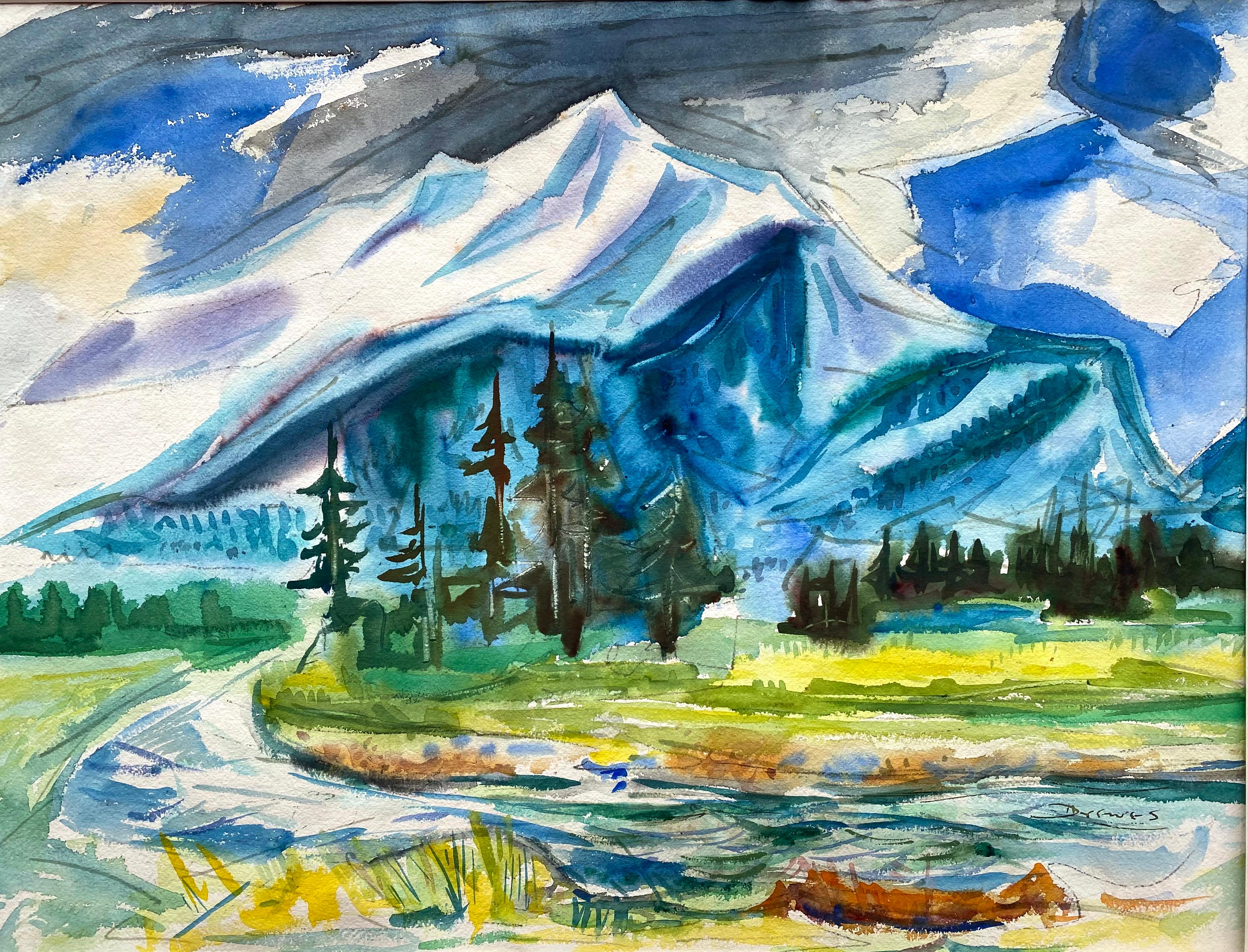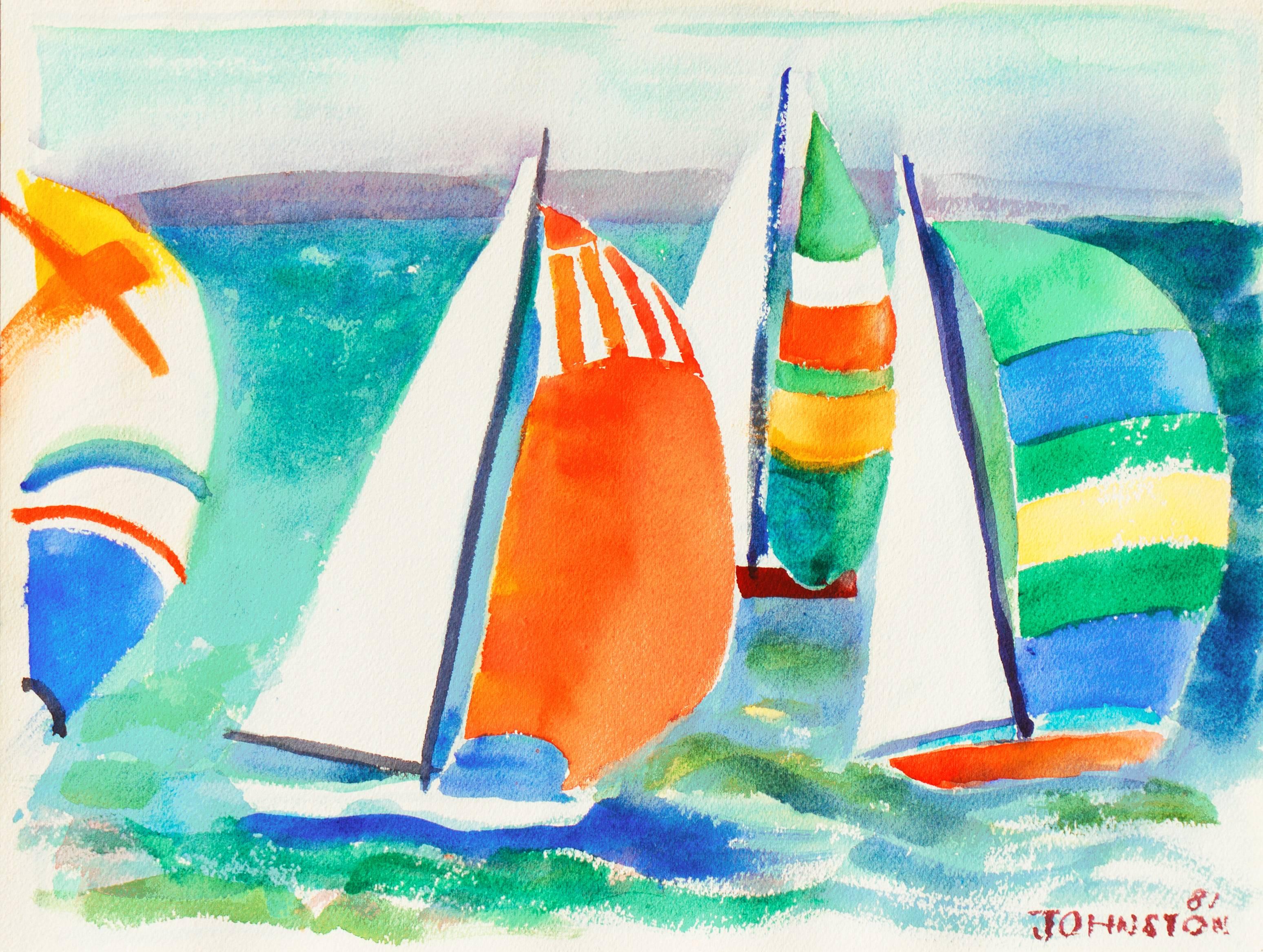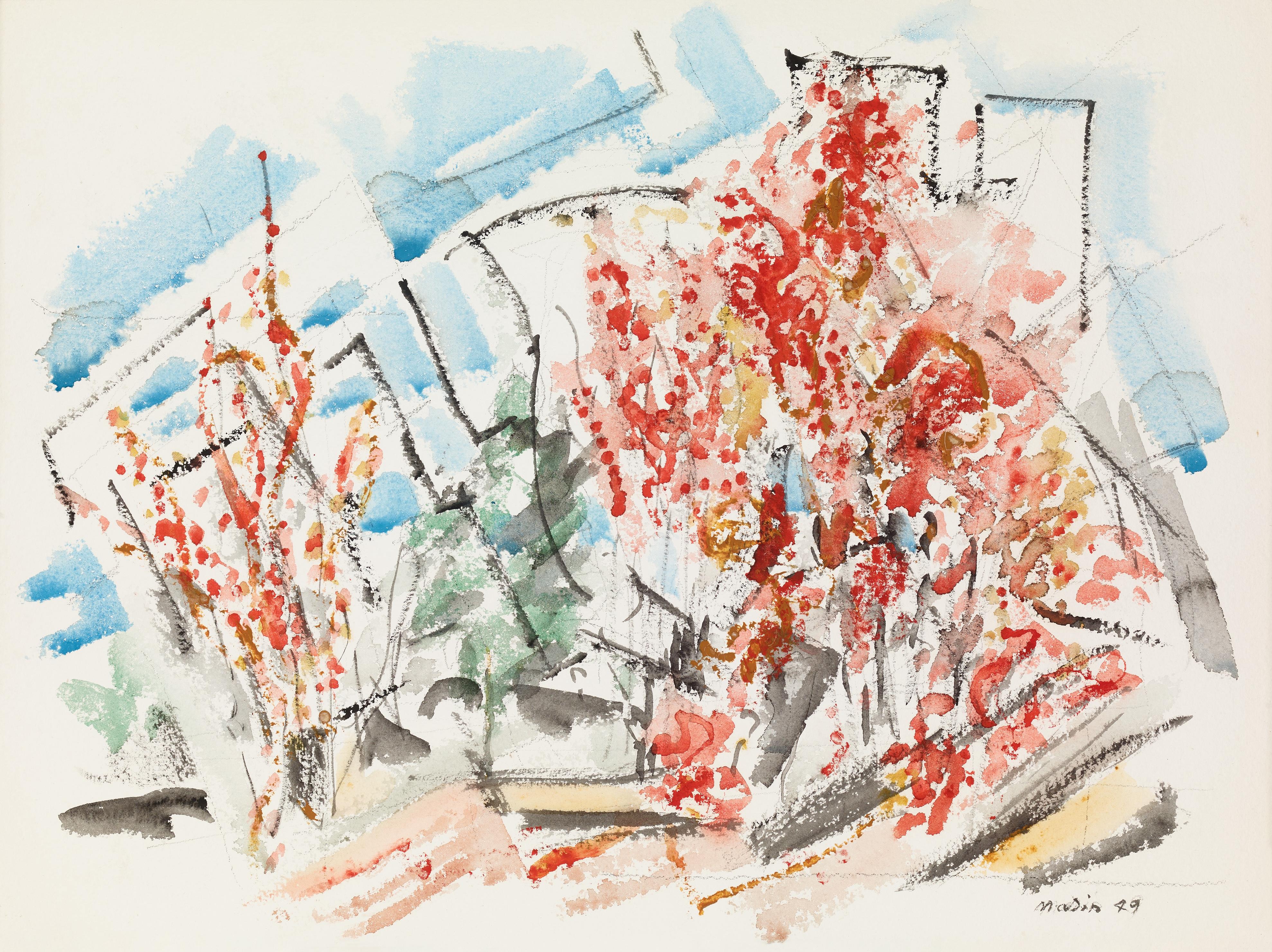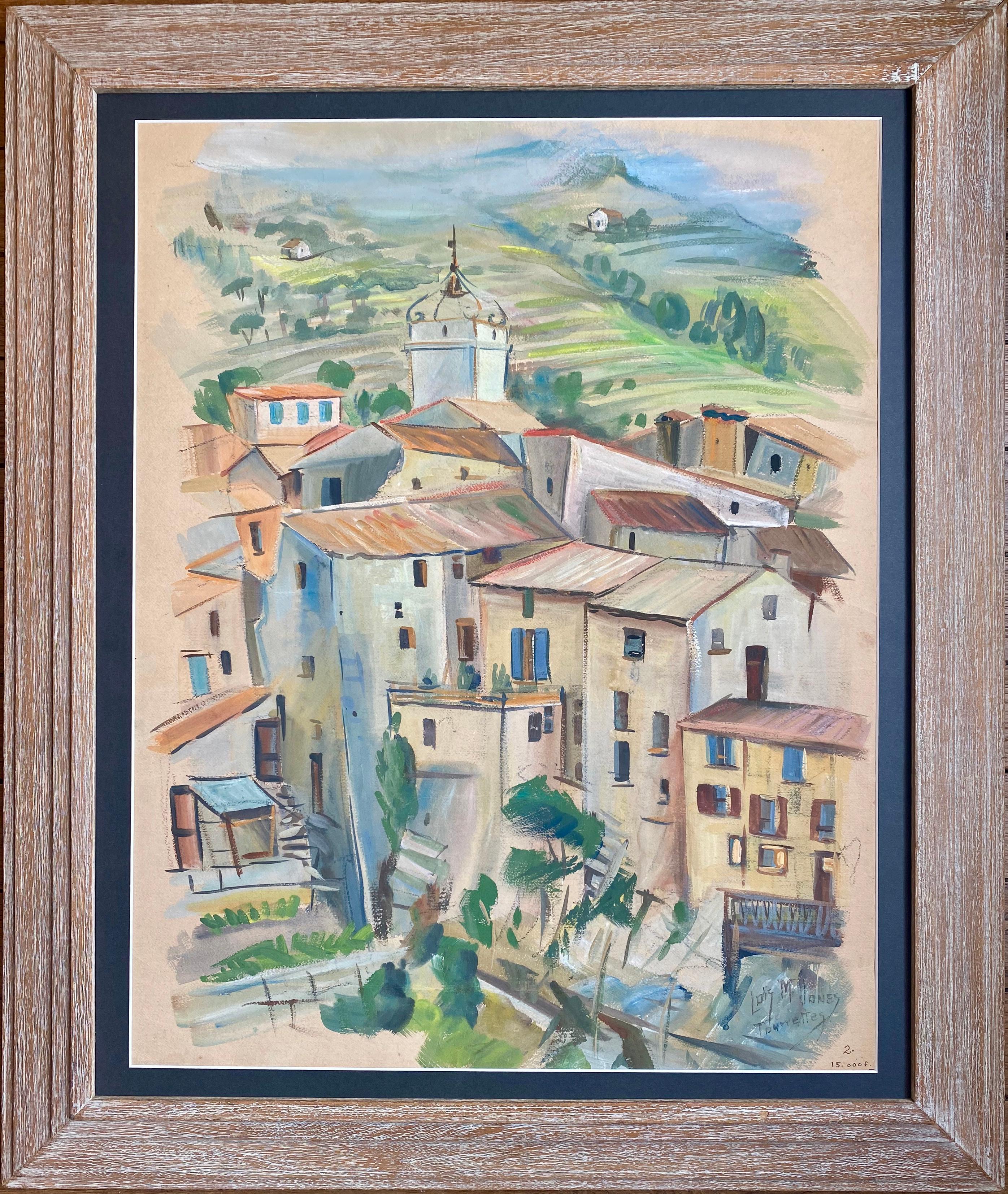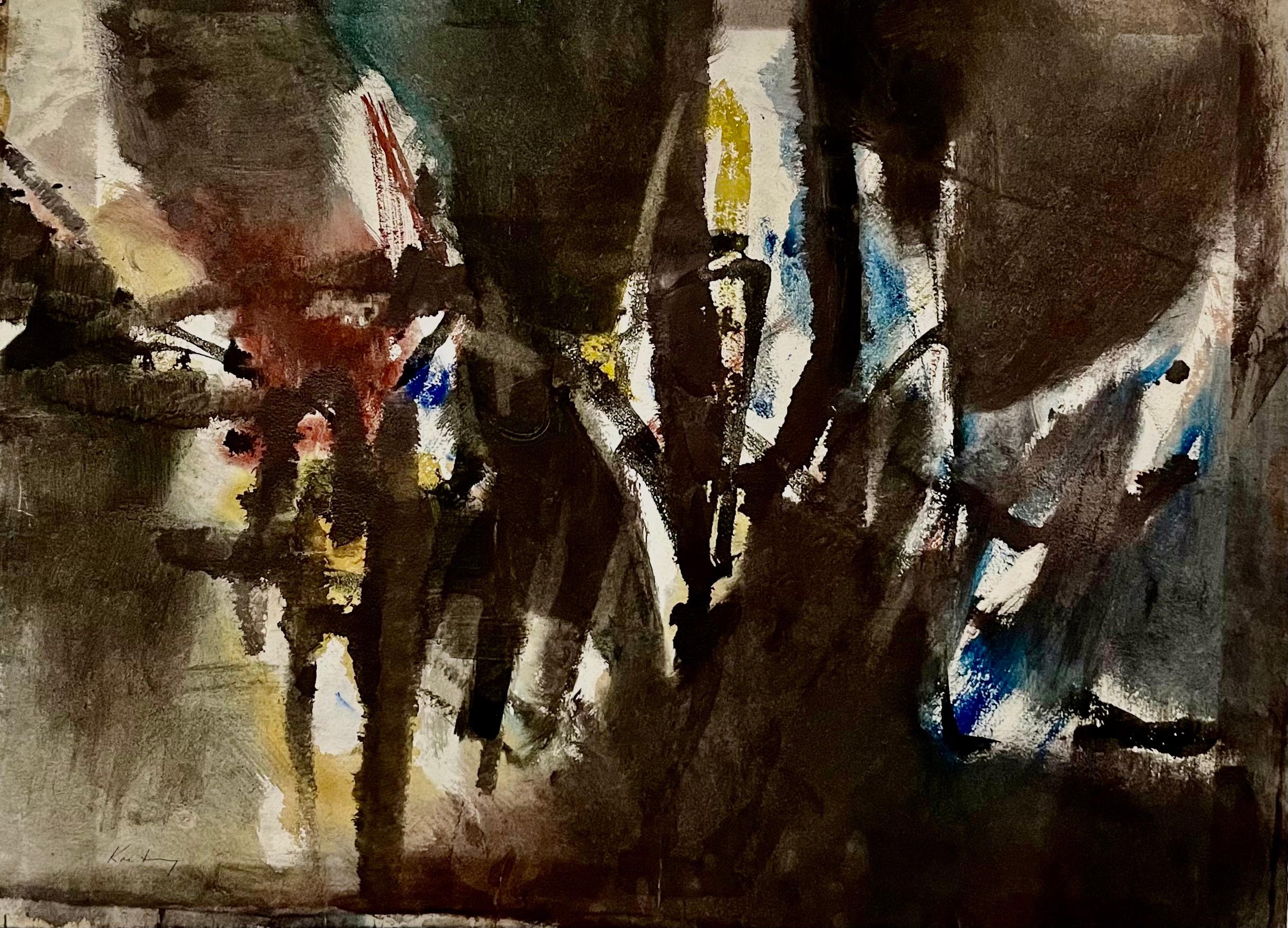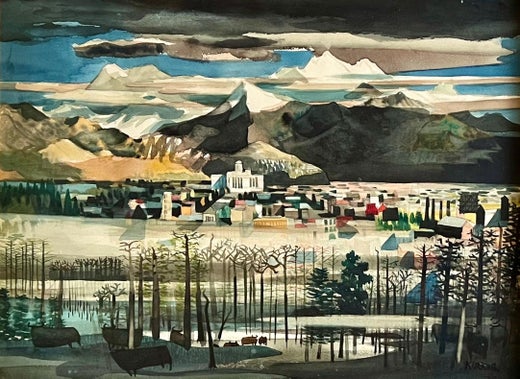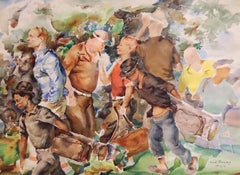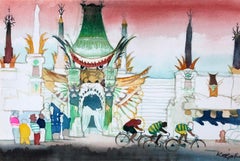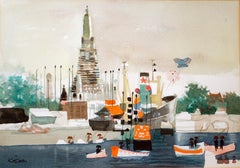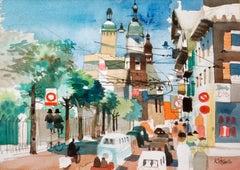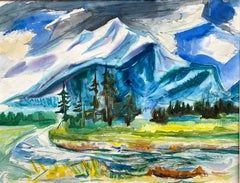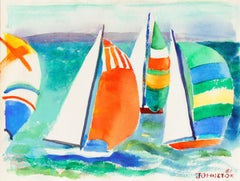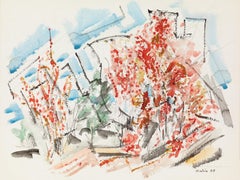Items Similar to New York Harbor
Want more images or videos?
Request additional images or videos from the seller
1 of 16
Dong KingmanNew York Harborc. 1940s
c. 1940s
About the Item
Dong Kingman
"New York Harbor" c. 1940s
watercolor on paper
Signed
*This is fully illustrated in the book, "Dong Kingman An American Master" (see attached images).
Sheet Size: 22 x 30 inches
Framed Size: approx. 33.5 x 40.5 inches
This is a wonderful painting by the legendary artist, Dong Kingman (1911-2000). Great period for the artist, with his bold color and whimsical approach.
The following obituary is from Dong Kingman Jr., son of the artist:
Dong Kingman, the world-renowned artist and teacher, died in his sleep on May 12, 2000 at age 89 in his home in Manhattan. The cause was pancreatic cancer.
Long acknowledged as an American watercolor master, he has received an extraordinary number of awards and honors throughout his 70-year career in the arts. Included are two Guggenheim fellowships in 1942 and 1943; the San Francisco Art Association First Purchase Prize, 1936; Audubon Artist Medal of Honor, 1946; Philadelphia Watercolor Club Joseph Pennel Memorial Medal, 1950; Metropolitan Museum of Art Award, and the National Academy Design 150th Anniversary Gold Medal Award, 1975.
In 1987, the American Watercolor Society awarded Dong Kingman its highest honor, the Dolphin Medal, "for having made outstanding contributions to art especially to that of watercolor."
His work is represented in the permanent collections of 50 museums and universities, including the Boston Museum of Fine Arts, M.H. deYoung Memorial Museum of Art, the Metropolitan Museum of Art, the Whitney Museum, Museum of Modern Art, Art Institute of Chicago, Pennsylvania Academy of Fine Arts, Sheldon Memorial Art Gallery and Sculpture Garden, Des Moines Art Center, Columbus Museum of Arts and Crafts, Brooklyn Museum and Hirshhorn Museum.
Born in Oakland, California in 1911 of Chinese descent, Kingman moved to Hong Kong at age five. He studied art and calligraphy in his formative years at the Lingnan School. The painting master Szeto Wai had recently studied art in Paris and took a keen interest in young Dongs precocious talents. He taught him both Chinese classical and French Impressionist styles of painting. Kingman returned home to Oakland when he was 18 at the height of the Depression. He worked as a newsboy and dishwasher to make ends meet.
When he was employed as a houseboy for the Drew family in San Francisco, he painted every spare moment. In a year, he created enough pictures to have a one-man show at the Art Center. It attracted the attention of San Francisco art critics who raved about Kingmans unique style. Wrote Junius Cravens of the San Francisco News: "That young Chinese artist is showing 20 of the freshest and most satisfying watercolors that have been seen hereabouts in many a day Kingman already has developed that universal quality which may place a sincere artist work above the limitations of either racial characteristics or schools. Kingmans art belongs to the world at large today." Dong Kingman became an overnight success.
From 1936 to 1941, he was a project artist for WPA and became a pioneer for a new school of painting, the "California Style." His two Guggenheim fellowships enabled him to travel the country painting American scenes. His first one-man show in New York at Midtown Galleries in 1942 was well received in the media, including Time, Newsweek, the New Yorker and American Artist. M.H. de Young Memorial Museum in San Francisco held a major exhibit of his watercolors in 1945.
In 1951, Midtown presented a 10-year retrospective of his work. Time Magazine wrote, "At age 40, Kingman is one of the worlds best watercolorists." Other retrospectives, including Corcoran in Washington,D.C. an d Witte Memorial Museum in San Antonio, were held for the artist. Kingman moved to Wildenstein (1958-1969) where he had successful exhibits in New York, London and Paris. Hammer Galleries exhibited his paintings in the 70s, and then the artist expanded his venues to the West Coast and Far East.
During World War II, he served with the OSS in Washington, D.C. where he was a cartographer. After his honorable discharge, Kingman moved to Brooklyn Heights from San Francisco when he became a guest lecturer and then art instructor at Columbia University (1946-1958). Hunter College also appointed him instructor in watercolors and Chinese Art (1948-1953). His teaching career continued with the Famous Artists School, Westport, CT in 1953, joining such distinguished artists on the faculty as Will Barnet, Stuart Davis, Norman Rockwell and Ben Shahn.
He also became a teaching member for 40 years for the Hewitt Painting Workshops, which conducts worldwide painting tours. He taught at the Academy of Art College in San Francisco, was a member of its board, and received an honorary doctorate from the Academy.
In 1954, the U.S. Department of State invited Kingman to go on a cultural exchange program tour around the world to give exhibitions and lectures and to meet local artists. When he came home, he presented the State Department with a 40-foot long report on a scroll, which later appeared in LIFE Magazine.
One of Kingman's most treasured experiences was his invitation by the Ministry of Culture of the Peoples Republic of China to exhibit in that country in 1981. He was the first American artist to be accorded a one-man show since diplomatic relations resumed. More than 100,000 visitors attended his exhibitions in Beijing, Hangzhou and Guangzhou and the retrospective received critical acclaim from the Chinese press. Noted the China Daily Mail, "Just as the master painters of the Song Dynasty roamed about mountain and stream to capture the rhythm of nature, Dong Kingman traveled the world capturing the dynamism of modern lifefamiliar scenes have been transformed into a vibrant new vision of life through color schemes with rhythms that play over the entire surface of the picture. The wind swept skies which enliven his watercolors remind us of the pleinairism of the French Impressionists."
Kingman, who has been fascinated with movies since seeing his first film "The Thief of Baghdad",, distinguished himself in this field as well. In 1954, the Academy Award-winning cinematographer James Wong Howe directed and photographed the exceptional 15-minute documentary, "Dong Kingman." Kingman produced, directed and animated "Hong Kong Dong" which received the Outstanding Achievement Award for Best Short Film at the San Francisco International Film Festival in 1976.
Inevitably, Hollywood beckoned the celebrated watercolorist. His watercolors were used to set the visual moods in the films "Flower Drum Song" (Universal, 1961) and "55 Days At Peking" (Allied Artists, 1963), both giving the artist film credit. He served as technical advisor for "The World of Suzie Wong" (Paramount, 1964) and contributed his artwork to motion pictures including "Circus World" (Paramount, 1964); "King Rat" (Columbia, 1965); "The Sand Pebbles" (20th Century Fox, 1966); "The Desperados" (Columbia, 1969) and "Lost Horizons" (Columbia, 1973).
In the summer of 2000, the Academy of Motion Picture Arts and Sciences highlighted Kingman's involvement in films with a special two-month exhibition "Dong Kingman: An American Master in Hollywood" that commemorated his film-related work in the permanent collection of the Margaret Herrick Library at the Academy Center for Motion Picture Study in Beverly Hills, CA.
His books include: The Watercolors of Dong Kingman, text by Alan D. Gruskin, introduction by William Soroyan (Crowell, 1958); San Francisco: City On Golden Hills, Herb Caen/Dong Kingman (Doubleday, 1967); Dong Kingmans Watercolors, with his wife Helena Kuo Kingman (Watson-Guptill, 1980); Paint the Yellow Tiger, Dong Kingman (Sterling, 1991); and Portraits of Cities, Dong Kingman (22nd Century Film Corp., 1997).
He has executed many commissions from magazine covers for Time, Life, Fortune, New York Times, and Saturday Review, to murals for the Bank of California, Dime Savings Bank New York, Ambassador Hotel, Hong Kong, and the Boca Raton Hotel. The mural East Meets West that he painted for the Lingnan Restaurant in Manhattan was rescued, restored and subsequently donated to the Brooklyn Public Library by Roslyn and Eugene Gamiel in 1997. The mural is now installed in the Librarys Multilingual Center. Among his posters, he created the OpSail, 1976 and 1986 editions as well as the 100th Anniversary of the Olympics Games poster for the Games held in Atlanta.
Among his charitable activities, he was the honored guest of Hong Kong Rotary International sponsored exhibit in June 1997 where the sale of his works at the handover festivities raised $70,000 for charities in Hong Kong. He contributed numerous watercolors to charitable organizations, including the World Federation of United Nations Association Limited Edition art program and UNICEF.
In recent years, the Taipei Fine Arts Museum in Taiwan exhibited "40 Years of Watercolors by Dong Kingman" from November 1994 through January 1995. In 1999, the Taichung Provincial Museum in Taiwan presented a retrospective of Dong Kingmans watercolor paintings.
A national touring retrospective,"Dong Kingman: An American Master" with venues at the Governors Gallery, Legislative Building, Olympia, WA; Chinese Culture Center, San Francisco, CA; Louisiana Arts & Science Center, Baton Rouge, LA; and Brooklyn Public Library, N.Y. began in the Fall of 2000 and closes at the end of 2001 in New York. Washington's Governor Gary Locke commented,"I was looking at more than just paintings. The artist deftly brings together elements of his Chinese heritage and life in America. The paintings tell a story of a mans quest to unite the best of both his worlds." The retrospective is being organized by the Institute of Chinese Culture and Arts and the curator is Monte James. Major funding is provided by the Starr Foundation.
In 2001, activities honoring the artist include the presentation of the first annual American Watercolor Society Dong Kingman award; establishment of a Dong Kingman fellowship in the Visual Arts Division at the Columbia University School of the Arts; inclusion in the "Leading the Way"exhibit of pioneering Asia American artists held at Gordon College, Massachusetts and an upcoming Dong Kingman exhibition being planned by the Chinese Historical Society of America to launch its new facilities in San Francisco.
- Creator:Dong Kingman (1911 - 2000, American, Chinese)
- Creation Year:c. 1940s
- Dimensions:Height: 33.5 in (85.09 cm)Width: 40.5 in (102.87 cm)Depth: 1 in (2.54 cm)
- Medium:
- Movement & Style:
- Period:
- Condition:
- Gallery Location:Missouri, MO
- Reference Number:1stDibs: LU74732463093
Dong Kingman
Born in Oakland, CA on March 31, 1911. When Kingman was five, his family moved to Hong Kong where he grew up and attended Lingnan Grammar School. The headmaster of the school, Szetu Wei, had studied painting in Paris and recognized his budding artistic talent. For several years he trained young Kingman in both oriental and occidental approaches to painting. Returning to San Francisco in 1929, Kingman became active in the local art scene and began painting scenes of the city. His first solo show at the San Francisco Art Center in 1936 brought immediate recognition. During the 1930s he spent five years working on commissions for the Federal Public Works of Art Project. During WWII he created maps and charts for the O.S.S. After the war Kingman settled in NYC and taught at Columbia University. His paintings were used as backdrops for the movie "Flower Drum Song" and his watercolors were reproduced in Life and on the covers of Fortune and Holiday magazines. Kingman died in NYC on May 12, 2000. Member: American WC Society; NA (1951). Exh: SFMA Inaugural, 1935; Vallejo Public Library, 1935; Calif. WC Society, 1935-44; San Francisco Art Association, 1936 (1st prize); GGIE, 1939; San Diego FA Gallery, 1943; De Young Museum, 1945 (solo); County Fair (LA), 1949; Philadelphia WC Club, 1950 (medal); NAD, 1975 (gold medal). In: MM; SFMA; Boston Museum; Delaware Museum; Whitney Museum (NYC); MOMA; CHS; Brooklyn Museum; De Young Museum; San Diego Museum; Mills College (Oakland); AIC; NAD; Butler Art Inst. (Columbus, OH); Wilmington (DE) Society of FA; Toledo (OH) Museum; Dartmouth College; U.S. State Dept; Addison Gallery (Andover, MA); Evansville Museum.
About the Seller
5.0
Vetted Professional Seller
Every seller passes strict standards for authenticity and reliability
Established in 1970
1stDibs seller since 2017
153 sales on 1stDibs
Typical response time: 17 hours
- ShippingRetrieving quote...Shipping from: Missouri, MO
- Return Policy
Authenticity Guarantee
In the unlikely event there’s an issue with an item’s authenticity, contact us within 1 year for a full refund. DetailsMoney-Back Guarantee
If your item is not as described, is damaged in transit, or does not arrive, contact us within 7 days for a full refund. Details24-Hour Cancellation
You have a 24-hour grace period in which to reconsider your purchase, with no questions asked.Vetted Professional Sellers
Our world-class sellers must adhere to strict standards for service and quality, maintaining the integrity of our listings.Price-Match Guarantee
If you find that a seller listed the same item for a lower price elsewhere, we’ll match it.Trusted Global Delivery
Our best-in-class carrier network provides specialized shipping options worldwide, including custom delivery.More From This Seller
View AllGolfers
By Frederick Conway
Located in Missouri, MO
Golfers, 1928
Fred Conway (American, 1900-1973)
Signed and Dated Lower Right
18.5 x 24.5 inches
30.5 x 37 inches with frame
A member of the faculty of the Washington University Art ...
Category
1920s American Modern Figurative Drawings and Watercolors
Materials
Paper, Watercolor
Price Upon Request
Chinese Theater, Los Angeles
By Dong Kingman
Located in Missouri, MO
Dong Kingman
"Chinese Theater, Los Angeles" 1965
Watercolor on Paper
Sheet Size: 15 x 22 inches
Framed Size: approx 19 x 26 inches
Dong Kingman, the world-renowned artist and teacher, died in his sleep on May 12, 2000 at age 89 in his home in Manhattan. The cause was pancreatic cancer.
Long acknowledged as an American watercolor master, he has received an extraordinary number of awards and honors throughout his 70-year career in the arts. Included are two Guggenheim fellowships in 1942 and 1943; the San Francisco Art Association First Purchase Prize, 1936; Audubon Artist Medal of Honor, 1946; Philadelphia Watercolor Club Joseph Pennel Memorial Medal, 1950; Metropolitan Museum of Art Award, and the National Academy Design 150th Anniversary Gold Medal Award, 1975.
In 1987, the American Watercolor Society awarded Dong Kingman its highest honor, the Dolphin Medal, "for having made outstanding contributions to art especially to that of watercolor."
His work is represented in the permanent collections of 50 museums and universities, including the Boston Museum of Fine Arts, M.H. deYoung Memorial Museum of Art, the Metropolitan Museum of Art, the Whitney Museum, Museum of Modern Art, Art Institute of Chicago, Pennsylvania Academy of Fine Arts, Sheldon Memorial Art Gallery and Sculpture Garden, Des Moines Art Center, Columbus Museum of Arts and Crafts, Brooklyn Museum and Hirshhorn Museum.
Born in Oakland, California in 1911 of Chinese descent, Kingman moved to Hong Kong at age five. He studied art and calligraphy in his formative years at the Lingnan School. The painting master Szeto Wai had recently studied art in Paris and took a keen interest in young Dongs precocious talents. He taught him both Chinese classical and French Impressionist styles of painting. Kingman returned home to Oakland when he was 18 at the height of the Depression. He worked as a newsboy and dishwasher to make ends meet.
When he was employed as a houseboy for the Drew family in San Francisco, he painted every spare moment. In a year, he created enough pictures to have a one-man show at the Art Center. It attracted the attention of San Francisco art critics who raved about Kingmans unique style. Wrote Junius Cravens of the San Francisco News: "That young Chinese artist is showing 20 of the freshest and most satisfying watercolors that have been seen hereabouts in many a day Kingman already has developed that universal quality which may place a sincere artist work above the limitations of either racial characteristics or schools. Kingmans art belongs to the world at large today." Dong Kingman became an overnight success.
From 1936 to 1941, he was a project artist for WPA and became a pioneer for a new school of painting, the "California Style." His two Guggenheim fellowships enabled him to travel the country painting American scenes. His first one-man show in New York at Midtown Galleries in 1942 was well received in the media, including Time, Newsweek, the New Yorker and American Artist. M.H. de Young Memorial Museum in San Francisco held a major exhibit of his watercolors in 1945.
In 1951, Midtown presented a 10-year retrospective of his work. Time Magazine wrote, "At age 40, Kingman is one of the worlds best watercolorists." Other retrospectives, including Corcoran in Washington,D.C. an d Witte Memorial Museum in San Antonio, were held for the artist. Kingman moved to Wildenstein (1958-1969) where he had successful exhibits in New York, London and Paris. Hammer Galleries exhibited his paintings in the 70s, and then the artist expanded his venues to the West Coast and Far East.
During World War II, he served with the OSS in Washington, D.C. where he was a cartographer. After his honorable discharge, Kingman moved to Brooklyn Heights from San Francisco when he became a guest lecturer and then art instructor at Columbia University (1946-1958). Hunter College also appointed him instructor in watercolors and Chinese Art (1948-1953). His teaching career continued with the Famous Artists School, Westport, CT in 1953, joining such distinguished artists on the faculty as Will Barnet, Stuart Davis, Norman Rockwell and Ben Shahn.
He also became a teaching member for 40 years for the Hewitt Painting Workshops, which conducts worldwide painting tours. He taught at the Academy of Art College in San Francisco, was a member of its board, and received an honorary doctorate from the Academy.
In 1954, the U.S. Department of State invited Kingman to go on a cultural exchange program tour around the world to give exhibitions and lectures and to meet local artists. When he came home, he presented the State Department with a 40-foot long report on a scroll, which later appeared in LIFE Magazine.
One of Kingman's most treasured experiences was his invitation by the Ministry of Culture of the Peoples Republic of China to exhibit in that country in 1981. He was the first American artist to be accorded a one-man show since diplomatic relations resumed. More than 100,000 visitors attended his exhibitions in Beijing, Hangzhou and Guangzhou and the retrospective received critical acclaim from the Chinese press. Noted the China Daily Mail, "Just as the master painters of the Song Dynasty roamed about mountain and stream to capture the rhythm of nature, Dong Kingman traveled the world capturing the dynamism of modern lifefamiliar scenes have been transformed into a vibrant new vision of life through color schemes with rhythms that play over the entire surface of the picture. The wind swept skies which enliven his watercolors remind us of the pleinairism of the French Impressionists."
Kingman, who has been fascinated with movies since seeing his first film "The Thief of Baghdad...
Category
1960s American Modern Landscape Drawings and Watercolors
Materials
Watercolor, Paper
Price Upon Request
Bangkok
By Dong Kingman
Located in Missouri, MO
Bangkok
By Dong Kingman (American, 1911-2000)
Signed Lower Left
Unframed: 15" x 22"
Framed: 24" x 31"
Born in Oakland, CA on March 31, 1911. When Kingman was five, his family moved to Hong Kong where he grew up and attended Lingnan Grammar School. The headmaster of the school, Szetu Wei, had studied painting in Paris and recognized his budding artistic talent. For several years he trained young Kingman in both oriental and occidental approaches to painting. Returning to San Francisco in 1929, Kingman became active in the local art scene and began painting scenes of the city. His first solo show at the San Francisco Art Center in 1936 brought immediate recognition. During the 1930s he spent five years working on commissions for the Federal Public Works of Art Project. During WWII he created maps and charts for the O.S.S. After the war Kingman settled in NYC and taught at Columbia University. His paintings were used as backdrops for the movie "Flower Drum Song...
Category
20th Century American Modern Landscape Drawings and Watercolors
Materials
Watercolor
Price Upon Request
European City
By Dong Kingman
Located in Missouri, MO
European City
By Dong Kingman (American, 1911-2000)
Signed Lower Right
Unframed: 15" x 22"
Framed: 24" x 31"
Born in Oakland, CA on March 31, 1911. When Kingman was five, his family moved to Hong Kong where he grew up and attended Lingnan Grammar School. The headmaster of the school, Szetu Wei, had studied painting in Paris and recognized his budding artistic talent. For several years he trained young Kingman in both oriental and occidental approaches to painting. Returning to San Francisco in 1929, Kingman became active in the local art scene and began painting scenes of the city. His first solo show at the San Francisco Art Center in 1936 brought immediate recognition. During the 1930s he spent five years working on commissions for the Federal Public Works of Art Project. During WWII he created maps and charts for the O.S.S. After the war Kingman settled in NYC and taught at Columbia University. His paintings were used as backdrops for the movie "Flower Drum Song...
Category
20th Century American Modern Landscape Drawings and Watercolors
Materials
Watercolor
Price Upon Request
Asian City
By Dong Kingman
Located in Missouri, MO
Asian City
By Dong Kingman (American, 1911-2000)
Unframed: 22" x 15"
Framed: 31" x 24"
Signed Lower Left
Born in Oakland, CA on March 31, 1911. When Kingman was five, his family moved to Hong Kong where he grew up and attended Lingnan Grammar School. The headmaster of the school, Szetu Wei, had studied painting in Paris and recognized his budding artistic talent. For several years he trained young Kingman in both oriental and occidental approaches to painting. Returning to San Francisco in 1929, Kingman became active in the local art scene and began painting scenes of the city. His first solo show at the San Francisco Art Center in 1936 brought immediate recognition. During the 1930s he spent five years working on commissions for the Federal Public Works of Art Project. During WWII he created maps and charts for the O.S.S. After the war Kingman settled in NYC and taught at Columbia University. His paintings were used as backdrops for the movie "Flower Drum Song...
Category
20th Century American Modern Landscape Drawings and Watercolors
Materials
Watercolor
Price Upon Request
Zurich
By Dong Kingman
Located in Missouri, MO
Zurich
By Dong Kingman (American, 1911-2000)
Unframed: 22" x 15"
Framed: 31" x 24"
Signed Lower Right
Born in Oakland, CA on March 31, 1911. When Kingman was five, his family moved to Hong Kong where he grew up and attended Lingnan Grammar School. The headmaster of the school, Szetu Wei, had studied painting in Paris and recognized his budding artistic talent. For several years he trained young Kingman in both oriental and occidental approaches to painting. Returning to San Francisco in 1929, Kingman became active in the local art scene and began painting scenes of the city. His first solo show at the San Francisco Art Center in 1936 brought immediate recognition. During the 1930s he spent five years working on commissions for the Federal Public Works of Art Project. During WWII he created maps and charts for the O.S.S. After the war Kingman settled in NYC and taught at Columbia University. His paintings were used as backdrops for the movie "Flower Drum Song...
Category
20th Century American Modern Landscape Drawings and Watercolors
Materials
Watercolor
Price Upon Request
You May Also Like
“Rocky Mountain Meadow”
By Werner Drewes
Located in Southampton, NY
Original watercolor on archival paper of a Rocky Mountain Meadow by the well known American artist, Werner Drewes. Signed lower right. Titled and dated 1956 on verso of sheet. Con...
Category
1950s American Modern Landscape Drawings and Watercolors
Materials
Watercolor, Archival Paper
$2,800 Sale Price
22% Off
'Evening Landscape' Bay Area Abstraction, San Francisco Museum of Fine Arts, CWS
By Robert George Gilberg
Located in Santa Cruz, CA
Signed lower right, 'Gilberg' for Robert George Gilberg (American, 1911-1970) and painted circa 1965.
Born in Oakland, Robert George Gilberg first studied at the Oakland Art Center during the 1930s. Following service during WWII, he settled in Nevada City, California where he lived and painted until shortly before his death in San Francisco. Gilberg exhibited widely and with success and was the recipient of numerous medals, prizes and juried awards, including at the San Francisco Museum of Fine Arts...
Category
1960s American Modern Landscape Drawings and Watercolors
Materials
Paper, Ink, Watercolor
'Spinnakers at Sunset', California Watercolor Association, Pacific Grove Artist
By Lucille Marie Johnston
Located in Santa Cruz, CA
Signed lower right, "Johnston" and dated 1981.
Bearing exhibition label from 17th Pacific Grove Annual Watercolor Competition.
A vibrant Modernist watercolor brimming with color and compressed energy.
Born in California on May 26, 1907, Lucille Johnston settled in Glendale in the 1930's. She exhibited widely including at the California Watercolor...
Category
1980s American Modern Landscape Drawings and Watercolors
Materials
Paper, Watercolor
Maples in Autumn Foliage
By John Marin
Located in Bryn Mawr, PA
John Marin’s long and prolific career is best marked by his fervent love of painting and abiding belief that art must relate to lived experiences. His best work strikes a delicate ba...
Category
1940s American Modern Landscape Drawings and Watercolors
Materials
Paper, Watercolor
African American Woman artist Mailou Jones Cezannian Cote d'Azur cubist village
Located in Norwich, GB
If you are interested in African American Art and in Women in the Arts, I will certainly not need to introduce Lois Mailou Jones (1905-1988). Often associated with the Harlem Renaissance, her
work can be found in the collections of the Smithsonian American Art Museum, The Metropolitan Museum of Art, the National Museum of Women in the Arts, the Brooklyn Museum, the Museum of Fine Arts, Boston, Muscarelle Museum of Art, and The Phillips Collection. I am proud to present an original watercolour painting by the artist which dates from the late 1940s or early 1950s.
Jones was born in Boston, Massachusetts to a father who became the first African-American to earn a law degree from Suffolk Law School. Jones's parents encouraged her to draw and paint using watercolors during her childhood. She held her first solo exhibition at the age of seventeen in Martha's Vineyard.
He career began in the 1930s and she continued to produce art work until her death in 1998 at the age of 92. Her style shifted and evolved multiple times in response to influences in her life, especially her extensive travels. She felt that her greatest contribution to the art world was "proof of the talent of black artists". Her work echoes her pride in her African roots and American ancestry.
In 1937, Jones received a fellowship to study in Paris at the Académie Julian, bringing her to France for the first time. The French were appreciative of her paintings and talent and Loïs Mailou Jones was thrilled at the country’s racial tolerance, so different from her reality in the United States.
She summered in France annually from 1945 to 1953, sharing studio with her lifelong friend Celine Marie Tabary in Cabris, France.
It was during one of these sojourns that the lovely work presented here was created.
Our painting depicts the village of Tourettes sur Loup, just north of Nice, in the Provence Cote d'Azur region, about 14 miles from Cabris.
Please note its similarities with her painting "Arreau, Hautes-Pyrénées" in the National Museum of Women in the Arts.
Her portrayal of the picturesque village nestled in a valley evokes landscape paintings by Paul Cézanne, a stylistic influence she acknowledged.
Over the course of the following 10 years, Jones exhibited at the Phillips Collection, Seattle Art Museum, National Academy of Design, the Barnett-Aden Gallery, Pennsylvania's Lincoln University, Howard University, galleries in New York, and the Corcoran Gallery of Art. In 1952, the book Loïs Mailou Jones: Peintures 1937–1951 was published, reproducing more than one hundred of her art pieces completed in France.At the Barnett-Aden Gallery, Jones exhibited with a group of prominent black artists, such as Jacob Lawrence and Alma Thomas. These artists and others were known as the "Little Paris...
Category
Mid-19th Century American Modern Landscape Drawings and Watercolors
Materials
Watercolor, Gouache, Handmade Paper
Modernist Abstract Expressionist Watercolor Painting Bauhaus Weimar Pawel Kontny
By Pawel Kontny
Located in Surfside, FL
Abstract watercolor composition bearing the influence of the earlier color-block compositions of Paul Klee.
Pawel August Kontny, (Polish-German-American artist) He was born in Laurahuette, Poland, in 1923, the son of a wealthy pastry shop owner. In 1939 he began studying architecture in Breslau where he was introduced to the European masters and to the work of some of the German Expressionists, soon afterward banned as "degenerate artists" and removed from museums throughout Germany by the Nazi regime. His studies were interrupted by World War II. Drafted into the German army, traveling in many countries as a soldier, he sketched various landscapes but in 1945, he was captured and held as a prisoner of war in Italy. After the war, he studied at the Union of Nuremberg Architects to help design buildings to replace ones destroyed in the war. He recorded his impressions of the local population and the landscapes through his watercolors and drawings. Pawel Kontny thereafter moved to Nuremberg, Germany, becoming a member of the Union of Nuremberg Architects and helping to rebuild the city's historic center. He soon decided to concentrate on his professional art career. He married Irmgard Laurer, a dancer with the Nuremberg Opera. Pavel Kontny 's career as an artist was launched with his participation in an all German exhibition, held at the Dusseldorf Museum in 1952. He held one-man shows in Germany, Switzerland and the United States. During his trip to the United States in 1960, Kontny became instantly enamored with Colorado, and decided to relocate to Cherry Hills with his wife and two children. He quickly established himself in the local art community, being affiliated for a time with Denver Art Galleries and Saks Galleries. His subject matter became the Southwest. During this time he received the Prestigious Gold Medal of the Art Academy of Rome. His extensive travel provided material for the paintings he did using his hallmark marble dust technique. he also worked equally in pastel, watercolor, charcoal and pencil-and-ink. in a style which merged abstraction and realist styles, influenced by Abstract Expressionist painting and South Western American landscapes. This one bears the influence of Sam Francis. In the early 1960s he was one of only a few European-born professional artists in the state, a select group that included Herbert Bayer (1900-1985), a member of the prewar Bauhaus in Weimar and Dessau, Germany, and Roland Detre (1903-2001), a Hungarian modernist painter. As a Denver, Colorado resident, Pavel Kontny exhibited at galleries and museums throughout the United States, Germany and Japan. There, he was inspired by frequent trips to Native American pueblos in the Southwest, as well as by the study of the Plains Indians of Montana and Wyoming. Over the years Kontny had a number of students and generously helped young artist by hosting exhibitions at his Cherry Hills home. For many years he generously donated his paintings to support charitable causes in Denver. Influences during his European years included German pastelist C.O. Muller, German Informel painter Karl Dahmen and Swiss artist, Hans Erni. In the early 1950s his painting style showed the influence of the Die Brücke (The Bridge), a group of German expressionist artists formed in Dresden in 1905 who had a major impact on the evolution of modern art in the twentieth century in Germany. By the middle of the decade his style incorporated more referential abstraction and total abstraction, resulting in part from his study of Hans Hartung, a German artist based in Paris who exhibited his gestural abstract work in Germany. The American moon landing in 1969 inspired Paul Kontny...
Category
20th Century American Modern Abstract Drawings and Watercolors
Materials
Watercolor, Archival Paper
Recently Viewed
View AllMore Ways To Browse
Framed Photograph New York
New York City 1980
New York 1950 Painting
New York City 1940s
Exhibition Poster New York
New York City Posters
1950s New Look
Chinese New Year
New York City Travel Poster
1940s Travel Posters
New York City Vintage Poster
1950 Paintings Of New York City
1940 Paintings Of New York City
New York Restaurant
New York Harbor Painting
New York Wpa Painting
Calligraphy American
World War Ii 1940s Design
